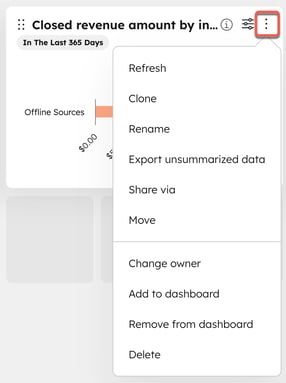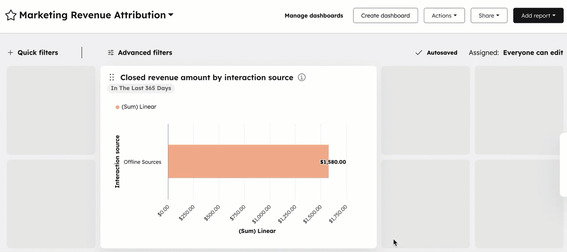- Knowledge Base
- Reporting & Data
- Dashboards
- Customize your dashboard
Customize your dashboard
Last updated: December 11, 2025
Available with any of the following subscriptions, except where noted:
When you have created your dashboard you can customize it to meet your business needs. Learn more about managing your dashboards.
Please note: dashboards cannot load reports that contain more than 100 values in the Break down by property. Instead, a Too many data points requested error will display.
Add reports to your dashboard
To add a new report to your dashboard:
- In your HubSpot account, navigate to Reporting > Reports.
- Hover over the report you want to add, click the Actions dropdown menu, then select Add to dashboard.
Please note:
- A dashboard is limited to a certain number of reports depending on your subscription. For more information on these limits, check out the HubSpot Product and Services Catalog. If you want to add more reports, you can create a new dashboard or remove reports from the current dashboard.
- If a report has the Show metrics toggle switched on, metrics will not appear on your report in the dashboard view. It will only appear in the individual report viewer.
Add reports to your dashboard in right side panel
To add a new report to your dashboard:
- In your HubSpot account, navigate to Reporting > Dashboards.
- Click Add content. Then, select Report.
- The right side panel, hover over a report, then click + Add to add the report to your dashboard.

- To edit the report within your dashboard, click the three vertical dots icon. Then, click the action you wish to complete.

Filter reports on your dashboard
The data a report displays depend on its filters. For better analysis, you should filter the data to a specific date range, specific owners or teams, or specific pipelines. You can filter all reports on a dashboard or filter individual reports.
Learn more about using dashboard filters.
Edit or customize reports on your dashboard
If you have access to custom reports, you can customize the reports on your dashboard.
Please note: the number of reports you can customize depends on your product subscription. Check your limits at HubSpot's Products & Services Catalog.
To customize a report on your dashboard:
- In your HubSpot account, navigate to Reporting > Dashboards.
- At the top, click the name of the current dashboard, and select the dashboard from the dropdown menu.
- Hover over the report you want to edit and click the filterIcon View and filter icon.
- In the dialog box, customize your report using the filters at the top or in the right side panel. Then click Update existing report or Save as new report to create a new report.
Move and resize reports on your dashboard
- In your HubSpot account, navigate to Reporting > Dashboards.
- Click the name of the current dashboard and select the dashboard from the dropdown menu.
- To reorganize the reports on your dashboard, click the report you want to move.
- Drag to move the report to the desired location on your dashboard.

- To resize a report, click the bottom right corner of the report on the dotted sizing arrow. Hold your left mouse button down and drag left or right to increase or decrease the size.

Rename, clone, remove, or delete reports on your dashboard
- In your HubSpot account, navigate to Reporting > Dashboards.
- In the upper left, click the name of the current dashboard, then select the dashboard you want to edit from the dropdown menu.
- Hover over the report and click the Actions dropdown menu:
- Rename: select to rename a report. In the dialog box, enter a new name in the New report name field, then click Save.
- Clone: select to clone the report. In the dialog box, enter a name for your new report and you can choose to add the new report to an existing dashboard or create a new dashboard to add it to. Click Clone to existing/new dashboard.
- Remove from dashboard: select to remove a report from the dashboard but not delete it.
- Delete: select to delete a report completely from your HubSpot account.
- Select the report and click Restore.
Add notes to your dashboard
You can add notes to a dashboard if you want to add context, extra information, or instructions for your team. Notes can include text, image, and video.
Please note: adding a note to a dashboard will count toward the limit of reports per dashboard. Learn more about how many reports you can have per dashboard for your subscription in the HubSpot Product and Services Catalog.
To add notes to a dashboard:
- In your HubSpot account, navigate to Reporting > Dashboards.
- In the upper left, click the name of the current dashboard, then select the dashboard you want to edit from the dropdown menu.
- In the upper right, click the Add content dropdown menu, then select Image or text.
- Enter your notes into the notes field, using the toolbar to format as needed. To add images or video, click the insertImage Insert image or insertVideo Insert video icons.
- After creating your notes, click Add to add them to the dashboard.
Customize your dashboard settings
Super Admin or users with Reports & dashboards permission in your account can view and make changes to all dashboards, regardless of visibility or ownership. Otherwise, a user can only make changes to dashboards they own or have access to.
- In your HubSpot account, navigate to Reporting > Dashboards.
- Click the name of the current dashboard and select the dashboard you want to edit from the dropdown menu.
- You can update the privacy setting for your custom dashboard. In the upper right, click the Assigned text.

-
- In the right side panel, customize your access settings:
- Private to owner: select to allow only your user and your admins to view and edit the dashboard. A Super Admin can only select this if they are the owner of the dashboard.
- Everyone: select to allow all users in your HubSpot account to view the dashboard.
- Select View and edit to allow all users to view and edit the dashboard.
- Select View only to allow all users to view, but not edit, the dashboard.
- Only specific users and teams (Enterprise only): select to allow specific users and teams in your HubSpot account to view the dashboard.
- Select View and edit to allow specific users to view and edit the dashboard. Click Next in the bottom right and select the users and teams that will have view and edit access to the dashboard and click Save.
- Select View only to allow specific users to view, but not edit, the dashboard. Click Next in the bottom right and select the users and teams that will have view access to the dashboard and click Save.
- In the right side panel, customize your access settings:
Please note: If a user does not have access to a dashboard, they can click Request access to trigger an email notification to the dashboard owner so the owner is aware and can grant them access.
- In the upper right, click the Actions or Share dropdown menu and select an action:
- Actions:
- Add external content: add content from external sources including Google Sheets, Youtube, Databox and more.
- Clone dashboard: select to clone the existing dashboard. In the right panel, enter the cloned Dashboard name and select the users who will have access to the cloned dashboard. Once selected, click Clone dashboard.
- Actions:
-
-
- Dashboard details: select to rename the dashboard, edit its description or change owner. In the right panel, edit the Dashboard name, edit the Dashboard description, or edit the dashboard owner. Once done, click Save.
-
-
-
- Set as default: select to make the dashboard your default. In the dialog box, click Set as default. Going forwards, this dashboard will be shown to you when you log in, or when you click the HubSpot sprocket in the top left.
- Delete: select to delete the dashboard. To keep the custom reports in your reports list, clear Also delete all reports in this dashboard. To confirm the deletion, click Delete dashboard.
-
-
- Share:
- Copy URL: select to copy the dashboard URL that you can share with other users in your HubSpot account.
- Email this dashboard: select to email the dashboard to a team member.
- Share: